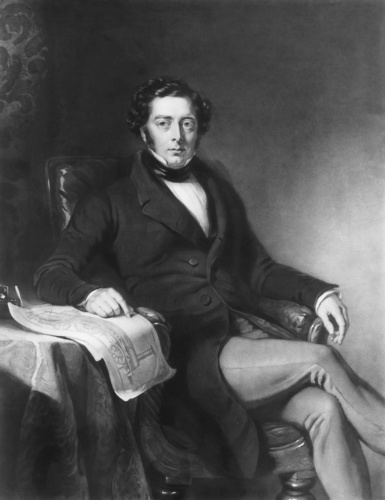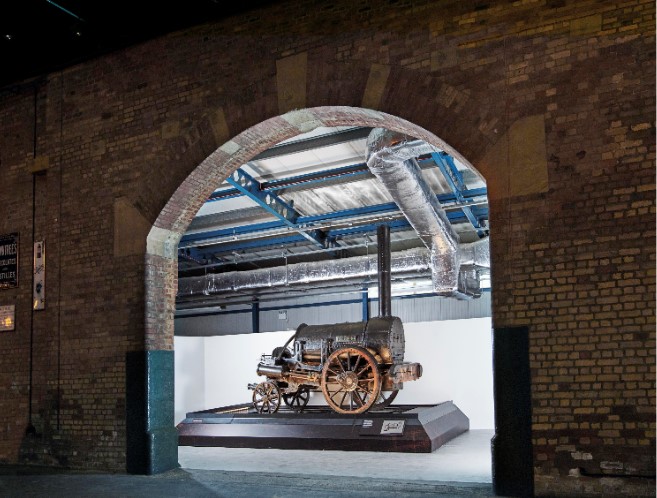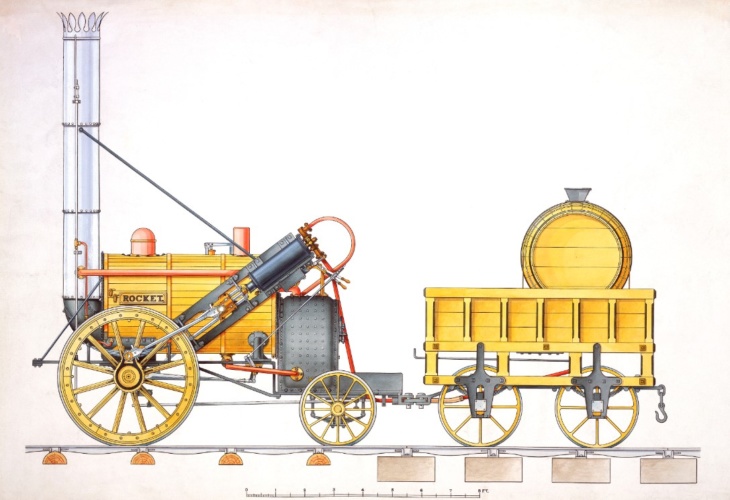In an early biography of the Stephenson father-and-son engineering dynasty, Samuel Smiles recalls the great railway and civil engineer Robert Stephenson doubting whether the public would be interested in reading about the life of his father George. “If people get a railroad,” he is reported to have said, “it is all they want; they do not care how or by whom it is done.”

And yet, the son co-operated in the production of a book that became a Victorian best seller and helped forge the unbreakable association between the name Stephenson and railway engineering. Although often attributed to his father, arguably the most famous locomotive ever built – Rocket – was designed by the son. It’s a common confusion arising from the fact that, as David Ross says in his 21st century double-header biography of the two men, to write about one without reference to the other is ‘impossible’. But for all the locomotives and railway line surveys, ultimately, Robert Stephenson’s legacy is founded on his prowess as a bridge-builder, most notably the Britannia Bridge over the Menai Strait in North Wales.
Born on 16th October 1803 in Northumberland, Robert Stephenson’s early life displayed few clues that he would become one of the greatest engineers of the 19th century. While his father George had been born to poor and illiterate parents (George was himself illiterate until the age of 18), Robert’s start in life was only marginally better. His father was a brakesman at the local colliery, and by the time he was three, his mother Agnes had died of tuberculosis. The infant Robert was subsequently left with a housekeeper while George departed for Scotland to look for work, eventually returning to the colliery at Killingworth, where he became an expert in steam machinery: the first step in an illustrious career that would make him ‘Father of Railways’. Despite having little formal education, George was determined that his son would benefit from one, and at the age of 11, Robert was sent to the Percy Street Academy in Newcastle, where he borrowed books that he would study with his father. In 1813, Robert was apprenticed to a local colliery manager, during which time he constructed a mining compass that he would later use to survey the High Level Bridge in Newcastle upon Tyne.
If people get a railroad, it is all they want; they do not care how or by whom it is done
While Robert was still an apprentice, his father became involved with surveying on the proposed Stockton and Darlington Railway (S&DR). With Robert showing signs of the illness that had accounted for his mother, he was released from his apprenticeship and went to work with his father. After the initial private bill for the S&DR failed before parliament, amendments were made to the route by the father-and-son team with the result that a subsequent bill was passed. George Stephenson, who had recommended the use of steam locomotives, was elected engineer for the project on a yearly salary of £660 that allowed him to send Robert to Edinburgh University (albeit for a less than a year), where he studied natural philosophy, natural history and science. By May 1823 final assent from came from parliament allowing the use of ‘loco-motives or moveable engines’. The following month Robert Stephenson & Co was established to build them, with Robert borrowing £500 to pay for his share in the company, a sum that dwarfed his £200 annual salary. By 1824 the S&DR had ordered two steam locomotives and two stationary engines from Robert Stephenson & Co, and the line opened in September 1825.
Robert was not there to see it because by June 1824 he was sailing to South America to oversee the installation of steam machinery in the gold and silver mines newly reopened by the Columbian Mining Association. Robert’s motive for taking up an appointment on the other side of the world has divided historians, who have seen his departure from the locomotive company as either because of a disagreement between the Stephensons over financial matters, or an indication that Robert was trying to break free from his father’s orbit. Either way, the trip could hardly be described as a success, with illness, labour problems and even a shipwreck thwarting the enterprise. After a brief tour of north America he returned to Britain where he resumed his role managing director of Robert Stephenson & Co, working on locomotive design – notably on Experiment and Lancashire Witch – as well as surveying railway routes and consulting on a tunnel under the River Mersey.

But it was the steam locomotive Rocket that was to be his career landmark of the decade. Designed by Robert and built at Robert Stephenson & Co’s Forth Street works in Newcastle, Rocket was by no means the first steam locomotive, despite its reputation for being so. But it was the most technologically advanced design of the time, bringing together several innovations that would establish the template for the steam locomotive for the following century. Rocket – how or when it got its name is unclear – was designed to take part in trials being conducted by the Liverpool and Manchester Railway (L&MR) at Rainhill. Because the line was intended as a predominantly passenger (rather than freight) service, the rules for the competition gave priority to speed and reliability. With weight restrictions in place, a key design decision was to opt for a single pair of drive wheels (the format of Rocket is 0-2-2, ie two driving wheels, two trailing wheels and no leading wheels). Increased efficiency was achieved by a multi-tubular boiler, while other innovations included close-to-horizontal pistons connecting directly to the drive wheels, and a separate firebox.
Rocket won the competition. The L&MR purchased it and placed an order for four similar units and the line opened on 15th September 1830 in the presence of the Duke of Wellington. This was somewhat overshadowed by the Member of Parliament for Liverpool William Huskisson becoming the first verifiable railway passenger fatality, having been run over by Rocket in a bizarre sequence of events. The resulting coverage of the accident, however, drew the public’s attention this new long-distance passenger transport technology.
Running parallel to Robert Stephenson & Co (and with the same directors) was the firm George Stephenson & Son that was contracted to survey a railway route from London to Birmingham. Still in his late twenties, on 20th September 1833 Robert signed the contract to build the 112-mile line from Camden Town to Birmingham on an annual salary of £1500, following which he moved to London, where he later established offices next door to the Institution of Civil Engineers and had the Herald’s College draw him up a coat of arms. Consolidation of his career as a railway entrepreneur came in the form of a long list of largely forgotten projects, including advising King Leopold on the Belgian State Railway (for which he was decorated with the Order of Leopold), an ill-fated investment in the Stanhope & Tyne Railroad Company, as well as advising on railways in France, Spain and Italy.

Robert was also the builder of many long-span railway bridges, of which the jewel in the crown is the Britannia Bridge that connects the island of Anglesey with mainland north Wales. A rivetted tubular bridge of wrought iron rectangular box-section spans supported by stone piers (the central one built on Britannia Rock), the specification insisted on by the Admiralty required the arches to be of sufficient height (100ft) to allow a fully rigged man-of-war to pass beneath. Robert borrowed the construction method from contemporary ship-building techniques and, to commemorate the structure’s completion, personally fitted the last rivet in 1850, a year after Queen Victoria opened his High Level Bridge in Newcastle.
Robert Stephenson spent the remainder of his career as the Conservative Member of Parliament for Whitby, his maiden speech in the House being in favour of the Great Exhibition of 1851 (of which he was a commissioner, alongside his friend Isambard Kingdom Brunel), and later speaking against Britain’s involvement in the Suez Canal scheme. At the height of his fame, he was also suffering from Bright’s Disease (chronic nephritis), which meant that he found the attention from prospective investors overbearing and would retreat to his yacht Titania, describing it as ‘the house that has no knocker.’ Returning to Britain from Oslo on Titania in 1859 he became seriously ill and died on 12th October 1859, merely days after the passing of Brunel. Such was the national impact of Robert’s death, Queen Victoria broke with protocol and granted his funeral cortège passage through Hyde Park, an honour traditionally reserved for royalty.
https://www.theengineer.co.uk/october-1859-robert-stephensons-obituary/










Invinity to build 20MWh flow battery in UK
Yuk - batteries are horrible, poisonous, short-lived and unsustainable things. It is about time that we invested in much more compatible mechanical...